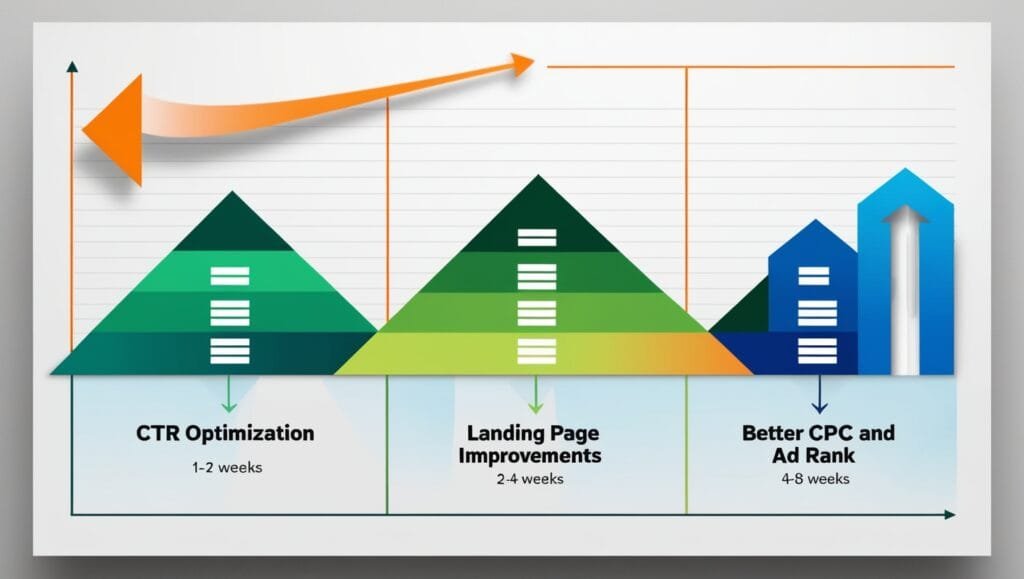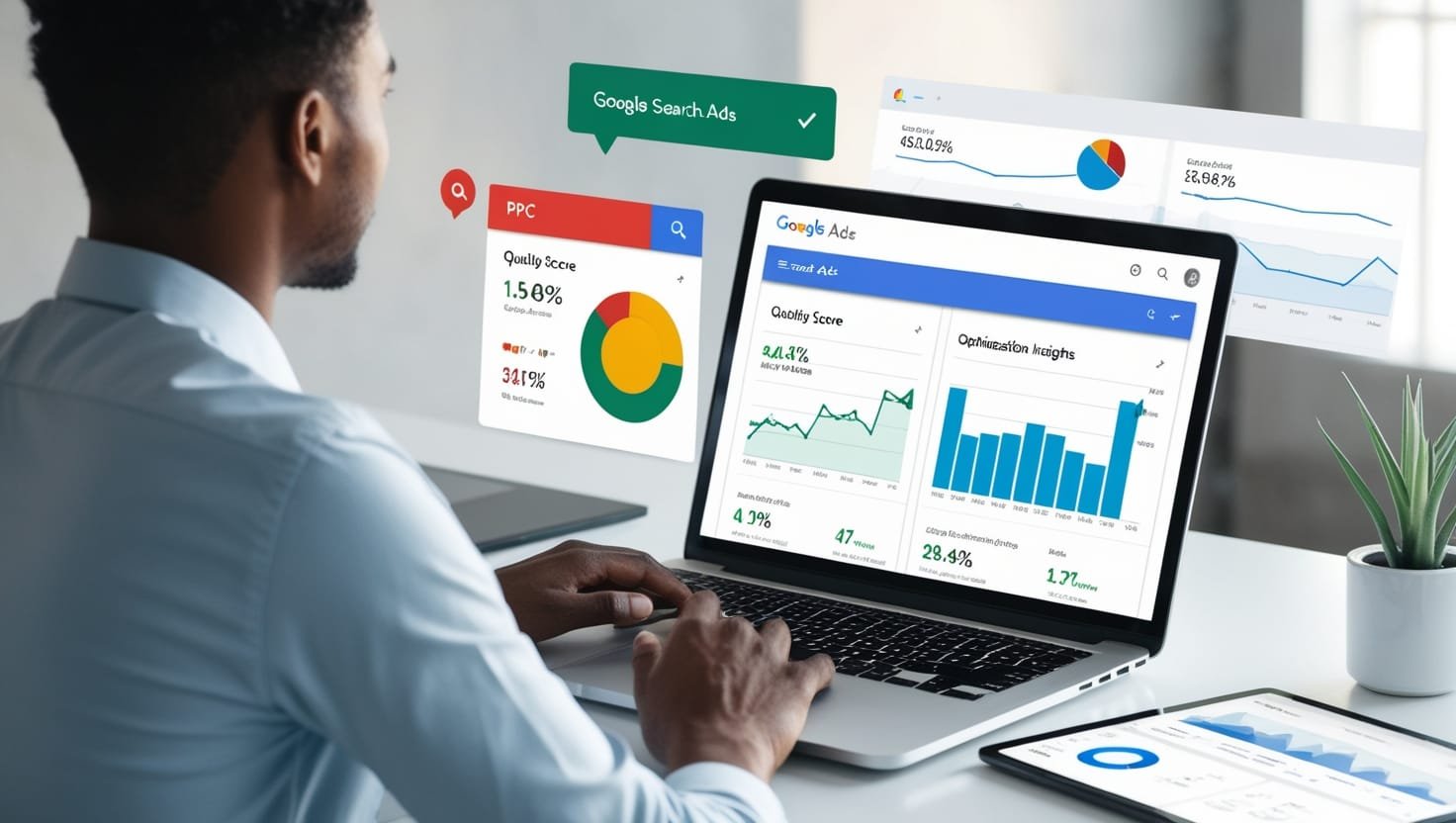One of the best tools available for digital marketing, Google Ads helps companies draw leads, generate focused traffic, and boost conversion rates. Still, success is about raising your Quality Score rather than only about bidding higher.
Better ad placements, cheaper costs per click (CPC), and a higher return on investment (ROI) follow from a higher Quality Score. We will define Quality Score in this guide, explain why it is important, and provide the basic actions you may take to raise it.
What is the Quality Score in Google Ads?
Your Quality Score is Google’s evaluation of the relevance and quality of your keywords, ads, and landing pages. On a one to ten rating, ten is the best quality. A high quality score shows that Google finds your advertisement rather relevant for consumer search inquiries.
Google bases its Quality Score on three main elements:
- Expected Click-Through Rate (CTR): Based on prior performance, what expected click-through rate (CTR) is for your advertisement.
- Relevance of Your Ad: How closely your advertisement corresponds to the search query’s intention?
- Landing Page Experience: How important, user-friendly, and worthwhile your landing page is to visitors?
Your advertisement placement in search results will be better and you pay less per click the higher your Quality Score.
Why Does Quality Score Matter?

Your Google Ad campaigns’ performance directly depends on quality score. Here’s why it’s so important:
- Lower Cost Per Click (CPC): Higher Quality Scores result in a lower CPC, thereby saving you money.
- Higher Ad Rankings: Google gives high Quality Score advertising top priority, therefore enhancing visibility.
- Better Conversion Rates: More conversions result from pertinent ads and improved landing pages.
- Improved ROI: Reduced ad expenses and improved performance translate into larger return on investment.
Knowing its value now, let’s look at ways to raise your Google Ads Quality Score.
How to Improve Quality Score in Google Ads
1. Optimize Your Keywords for Relevance
Using very relevant keywords raises your Ad Relevance and CTR. This is how:
- Use Long-Tail Keywords: These better match search intent and raise clickthrough rates.
- Group Keywords into Tight Ad Groups: Steer clear of wide keyword groups and develop specialized ad groups including closely linked phrases.
- Use Negative Keywords: Use negative keywords to cut down pointless searches hence increasing relevancy and saving money.
For instance, target “top running shoes for men rather than “shoes.”
2. Improve Ad Copy for Higher Click-Through Rates (CTR)
Attracting clicks depends critically on your ad wording. See these effective practices to raise CTR:
- Include Target Keywords: Incorporate target keywords into headlines and descriptions.
- Write Compelling Headlines: Create compelling, action-packed headlines for your work.
- Add Unique Selling Propositions (USPs): Emphasize specials, free shipping, or discounts to create Unique Selling Propositions (USPs).
- Use Call-to-Actions (CTAs): Motivational tools including “Shop Now, “Get a Free Quote” help consumers to act.
Example of a high-CTR advertisement:
Headline: “50% Off Running Shoes – Free Shipping Today.”
Description: “Free delivery running shoes of shop top quality. Sale limited-time: Buy Now!
3. Optimize Landing Pages for Better User Experience
Your Quality Score suffers on a bad landing page experience. improve your landing pages by:
- Ensuring Page Speed is Fast: A slow page raises bounce rates. Maximize load time with Google PageSpeed Insights.
- Making Pages Mobile-Friendly: Mobile users should experience nothing but smoothness.
- Matching Ad Copy to Landing Page Content: Make sure the landing page addresses “affordable SEO services,” should your advertisement support such services.
Using clear CTAs like “Sign Up Now” or “Get a Free Consultation can help users achieve conversions.
4. Increase Expected Click Through Rate (CTR) with Ad Extensions

Google favors advertising with improved user experience. Boost CTR with ad extensions including:
- Sitelink Extensions: Point viewers to several pages on your website.
- Callout Extensions: Highlight further advantages (like “24/7 Customer Support”) in callout extensions.
- Structured Snippets: Showcase categories—e.g., “SEO Services: Keyword Research, On-Page SEO, Link Building”—in structured snippets.
- Call Extensions: To inspire direct calls, provide a phone number.
5. Maintain a High Ad Relevance Score
Google wants advertisements to be quite closely related to user searches. To increase Relevance for Advertisements:
- Use Dynamic Keyword Insertion (DKI): Dynamic keyword insertion (DKI) lets your ad content automatically include visitors’ search phrases.
- Avoid Generic Ads: Steer clear of generic ads; customize your ad copy for particular keywords.
- Keep Ads and Keywords Aligned: Make sure the landing page content, title, and description line search intent. Keep Ads and Keywords Alined.
6. Regularly Monitor & Optimize Your Campaigns

The process of raising quality scores never stops. Track and improve campaigns often using:
- Reviewing Google Ads Reports: Point up ineffective ad and keyword searches.
- A/B Testing Ads: Test several headlines, descriptions, and CTAs in A/B testing ads to identify the best-performance variants.
- Analyzing Bounce Rates: Should consumers fast depart your landing page, improve UX and page content.
- Changing Bids for High-Quality Keywords: Spend more in keywords with a high Quality Score and conversion rate.
Common Mistakes That Lower Quality Score

Many advertisers unintentionally commit blunders that lower their Quality Score. Steer clear of these land mines:
❌ Using Broad Match Keywords Without Refine: Broad match can set off pointless searches. For increased targeting, use phrase match or exact match.
❌ Poor Ad Copy – Generic or deceptive ad copy lowers Quality Score and increases CTR by poor means.
❌ Irrelevant Landing Pages: Verify the content of the landing page fits the advertisement promise.
❌ Slow Loading Pages: A slow website reduces user interaction and boosts bounce rates.
❌ Ignoring Negative Keywords – Ignoring negative keywords could cause your advertising to show in unrelated searches, thereby wasting money.
How Long Does It Take to Improve Quality Score?
Quality doesn’t change overnight. Improvements could show up a few days to several weeks depending on attempts at optimization.
Following is a broad timeline:
✅ 1-2 Weeks: Use better ad wording and extensions to raise CTR.
✅ 2-4 Weeks: perfect landing pages and keyword relevance.
✅ 4-8 Weeks: Lower CPC and improved ad rank follow from notable quality score increases in 4–8 weeks.
Final Thoughts
Lowering costs, better ad positions, and more conversions all depend on a Google Ads Quality Score being improved. Higher rankings and greater return on investment can be obtained by improving keywords, ad text, landing pages, user experience.
Main lessons:
✅ Use highly relevant keywords and group them into specific ad groups.
✅ Write compelling ad copy that includes primary keywords and clear
CTAs.
✅ Simplify landing pages for speed, mobile friendliness, and relevancy.
✅Use ad extensions to improve clickthrough rate and visibility.
✅ Track and improve your Google Ads efforts constantly.
Your Google Ads campaigns will run better, draw quality traffic, and get more conversions by using these techniques—without running additional ads.
Require assistance optimizing Google ads?
Our specialty at Sky Creators is Google Ads administration, PPC optimization, and Quality Score enhancement techniques. Get in touch now to improve the outcome of your campaign!


Leave a Reply